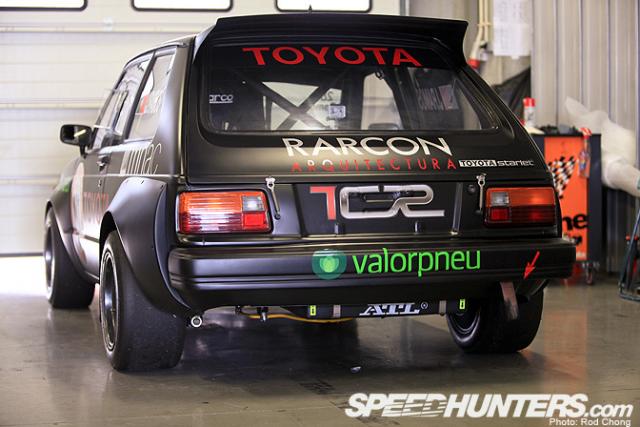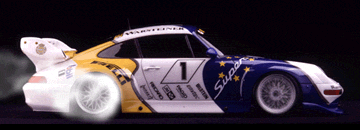
|
|
|||||||
| Home | Forum | Registrarse | Mini-Banners  |
Miembros | Calendario |
| Fotos / Videos de Automovilismo Fotos y videos relacionados con el automovilisimo, motos, etc... NO PORN! Just car porn :) |
|
|

|
 |
 Este thread fue creado hace 4146 días. Lo mas probable es que el tema ya se haya resuelto y no necesite más discusión. Aunque si todavía crees que es necesario agregar un comentario, puedes hacerlo. Este thread fue creado hace 4146 días. Lo mas probable es que el tema ya se haya resuelto y no necesite más discusión. Aunque si todavía crees que es necesario agregar un comentario, puedes hacerlo.
|
|
|
Herramientas |
|
|
#1 |
|
1000
Fecha de Ingreso: 21-January-2008
Mensajes: 3.019
Feedback Score: 10 reviews
|
The Porsche 917/10
 The Porsche 917/10 represents massive overwhelming force. That’s quite something when you’re talking about a car that was aimed at Can-Am, the ’70s race series that in its classic incarnation was based around a virtually no-limits, all-out power formula. This /10 and its younger, even more powerful sister the 917/30 represent the most ferocious, raw racing cars ever constructed.  Up until 1972, Can-Am had been McLaren’s hunting ground, but the arrival of the Porsche factory steamroller quickly reduced them to backmarkers – and also drove a nail into the coffin of the series. By 1973, Porsche 917s ended up carrying almost twice the horsepower of the previous generation cars, using a qualifying grenade of an engine that put out over 1,300hp.  The reason for this factory war machine being made was, as ever, a change of rules.  In 1972 Porsche had found themselves regulated out of their natural habitat of Le Mans and the World Sportscar Championship. The dominant 917 had won Le Mans twice in a row (’70 and ’71), laying the foundation for the marque’s future success at La Sarthe, but the incoming three-litre rules introduced to get some parity between F1 and sports cars didn’t appeal to the company. They decided to turn their attention to their biggest market, the USA. And that required a serious change in philosophy.  They would need power.  A whole lot more power.  Porsche needed to go back to the drawing board, but they hadn’t stood still with the 917 since it was first introduced in ’69.  The coupé had constantly evolved across its short life in World Sportscars, with short and long-tail versions, enclosed low-drag bodies and experimental aerodynamic variants all coming out of Zuffenhausen.  The 917 programme had also fast-tracked the Porsche technical team in developing new racing technologies. Magnesium, titanium and other exotic materials had been used for the Le Mans racer, the entire lightweight tubeframe was pressurised, the flat-12 used twin spark plugs and produced impressive power figures.  All these threads would come together for the firm’s major foray across the water: the 917/10.  Porsches had already competed in Can-Am, with low-key 908 entries and a 917K (a rough-cut spider version of the Le Mans coupé), but they had been underpowered and out-gunned in the face of the big V8s of the established opposition. For the new Can-Am programme, Porsche’s first concern was delivering more horsepower to the driver.  McLaren were clearly in the ascendancy in North America, with their Chevy V8-powered M8s producing obscene power – around 750hp even from their normally aspirated engines. A singleton NA 917/10 competed in 1971 did better than expected, even scoring second places at Mid Ohio and Road America, but it was clear where the problem lay.  The magnesium-alloy, 4.5 litre 180-degree V12 was retained (after a long-wheelbase car with a normally aspirated 7.2 litre 16-cylinder engine was tested and shelved) and raced during 1971 in a car that still bore a big resemblance to the 908. But serious firepower was added the following year in the form of a 5 litre flat 12 boxer assaulted by two big truck turbos. Turbos were still in their infancy during this period, so this was no mean feat, especially when delivered through a four-speed box.  But the result was close to a thousand horsepower and over 900Nm of torque, quickly rising as the car was developed and well exceeding the magical one horsepower per kilo formula…  … in a car weighing just 767kg.  That meant that driving a 917/10 was a delicate affair: power was delivered like a light switch, requiring subtle application of the throttle to prevent the huge rears spinning up and leaving you helplessly bogged down or facing in the wrong direction.  The boost was usually run at 1.3 during a race, with the maximum only used in bursts for qualifying. It was still more than enough.  The 917/10K got to 60mph in 2.1 seconds, 100 mph in 3.9 seconds and 200 mph in 13.4 seconds.  At its heart, an aluminium spaceframe bore all the components of this deceptively small car: the huge, overhanging rear wing and bluff nose make it look much larger than it actually is…  … but see it with a driver in the cockpit and you get a better sense of its true proportions.  The design approach also followed new conventions. Although hand-crafted curves had dominated, now sharp edges and slab sides came to the fore.  Though from face on you can see how the form of body is actually more slippery than you’d expect – it’s less wedge-shaped than the McLaren’s and looks more organic than when you see the car at from the side angle.  The huge rear wing dominates the back of the car, supported by aluminium strakes and secured to the raked rear upright fins.  But whatever the efficiency or not of its aero, it looked like the pure power of the Porsche would batter nature into submission.  The panels were GRP, consisting of two main sections – the big rear deck hinging up for access to the engine bay.  The bodywork directly in front of the front wheels was concave to help produce downforce, with louvres helping air flow.  The legendary Penske squad oversaw the main factory effort in 1972, now with the addition of those huge turbos. The L&M sponsorship was taken from Carl Haas’ Lola programme, transferring the beautifully clean livery (as so many cars of the time had) to the Porsche.  A McLaren M20 took the first win of the season at Mosport in June ’72, but the writing was on the wall: three 917/10s finished in the top five, with Mark Donohue second.  A testing accident ruled Donohue out of the next four rounds, so Penske brought in George Follmer, initially as a temporary substitute.  The following month at Road Atlanta, Follmer posted his first victory in the Porsche, then won the fourth (Mid Ohio), fifth (Road America), eighth (Laguna Seca) and ninth (Riverside) races, with the team running two cars when Donohue returned to action.  Follmer easily took the title, ending five years of McLaren domination.  As if the /10 wasn’t enough, and with the opposition already reeling, Porsche decided to take it up another level and produced the 917/30 for 1973, where a thousand horsepower was its lowest power setting. It was once aptly described as a total weapons system… but that’s another story.  917/10Ks continued to race on alongside the /30 through ’73, meaning that by the end of the season, races became Porsche benefits. There was a final outing for Porsche during the curtailed ’74 season, the last year of the classic Can-Am era before the series folded, killed off by a combination of the global oil crisis, spiralling costs and the hammer-blow dealt to the opposition by Porsche.  This is Follmer’s championship winning car, signed by the man himself.  The 917/10 brought power and glory to Porsche, and was proof that they could turn their hand to pretty much anything they fancied and still expect to win. The ’70s would provide further rich pickings for the team, especially when they returned to Le Mans with the turbocharged 936 (lessons well learned from the Can-Am project), but the 917/10 still stands as a pinnacle of ’70s racing cars, proving that nothing succeeds like excess…
__________________
 Milito |
|
|

|
|
|
|
#2 |
|
Club Jalapa
Fecha de Ingreso: 04-June-2006
Ubicación: Jalapa
SI/TS
Tiempo: ......
Mensajes: 4.500
Feedback Score: 32 reviews
|
Re: The Porsche 917/10
que nave, con esa gran cola como si ya fuera hacer caballito se mira jeje...
__________________
 #RedStar... "Old Racers Jalapa" |
|
|

|
|
|
#3 |
|
TEAM SAML
Fecha de Ingreso: 10-May-2009
Mensajes: 3.367
Feedback Score: 2 reviews
|
Respuesta: The Porsche 917/10

__________________

|
|
|

|
|
|
#4 |
|
kp36 / del sol SI
Fecha de Ingreso: 17-October-2011
Ubicación: Vagando
Dos pies andando
Tiempo: ..noc..
Mensajes: 11.539
Feedback Score: 97 reviews
|
Respuesta: The Porsche 917/10
fea pero esa onda debe correr avismalmente...

__________________
firma demasiado grande |
|
|

|
|
|
#5 |
|
Senior Member
Fecha de Ingreso: 28-July-2009
Ubicación: z 7
Mensajes: 18.790
Feedback Score: 2 reviews
|
Respuesta: The Porsche 917/10
no me gusta el diseño... pero ha de volar esa mierda
__________________
|
|
|

|
|
|
#6 |
|
BMW M6
Fecha de Ingreso: 03-August-2007
Mensajes: 1.735
Feedback Score: 24 reviews
|
Respuesta: The Porsche 917/10
No me gusta el diseño de ese carro, pero a de correr grueso. Con otro diseño deahuevo seria genial.
__________________

|
|
|

|
|
|
#7 |
|
Senior Member
Fecha de Ingreso: 12-June-2006
Ubicación: portodoslados
Tiempo: 000000000000
Mensajes: 3.515
Feedback Score: 1 reviews
|
Respuesta: The Porsche 917/10
el diseño corresponde a la época.
|
|
|

|
 |
|
|